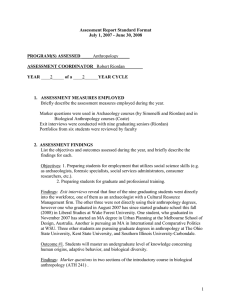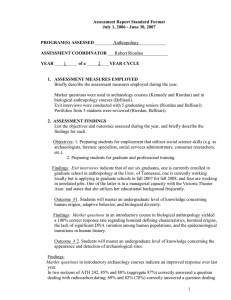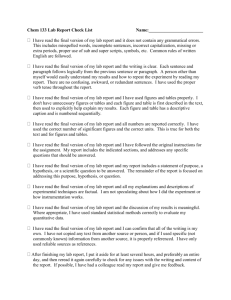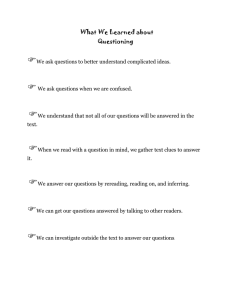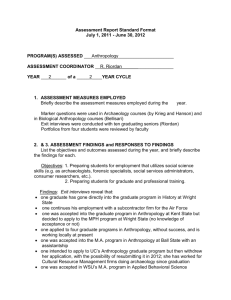Anthropology (B.A.)
advertisement
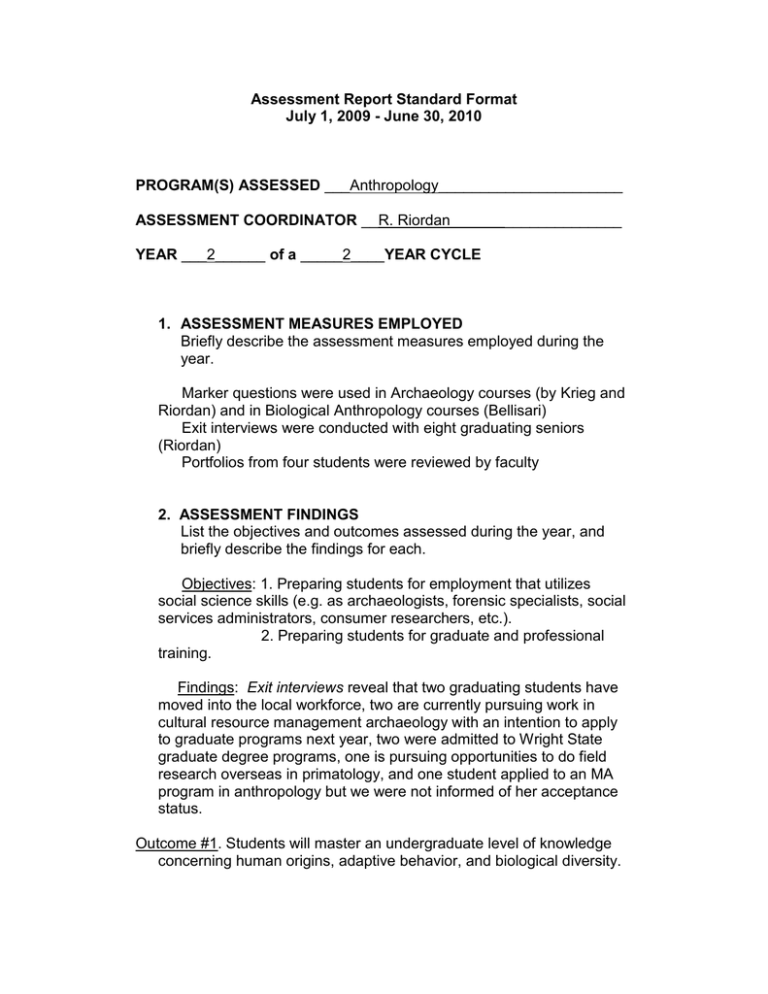
Assessment Report Standard Format July 1, 2009 - June 30, 2010 PROGRAM(S) ASSESSED ___Anthropology______________________ ASSESSMENT COORDINATOR __R. Riordan ______________ YEAR ___2______ of a _____2____YEAR CYCLE 1. ASSESSMENT MEASURES EMPLOYED Briefly describe the assessment measures employed during the year. Marker questions were used in Archaeology courses (by Krieg and Riordan) and in Biological Anthropology courses (Bellisari) Exit interviews were conducted with eight graduating seniors (Riordan) Portfolios from four students were reviewed by faculty 2. ASSESSMENT FINDINGS List the objectives and outcomes assessed during the year, and briefly describe the findings for each. Objectives: 1. Preparing students for employment that utilizes social science skills (e.g. as archaeologists, forensic specialists, social services administrators, consumer researchers, etc.). 2. Preparing students for graduate and professional training. Findings: Exit interviews reveal that two graduating students have moved into the local workforce, two are currently pursuing work in cultural resource management archaeology with an intention to apply to graduate programs next year, two were admitted to Wright State graduate degree programs, one is pursuing opportunities to do field research overseas in primatology, and one student applied to an MA program in anthropology but we were not informed of her acceptance status. Outcome #1. Students will master an undergraduate level of knowledge concerning human origins, adaptive behavior, and biological diversity. Findings: Marker questions in two sections of the introductory course in biological anthropology (ATH 241). 89% and 86% of students correctly answered a question about the evolutionary implication of universal DNA code; and 90% and 95% correctly answered a question about the general trend of human evolution. An 80% correct rate is accepted as demonstrating mastery of the concepts. Outcome # 2. Students will master an undergraduate level of knowledge concerning the appearance and detection of archaeological sites. Findings: Marker questions were used in one section (Spring 2010) of the introductory archaeology course produced a mixed response with respect to performance in the previous year. A question concerning the application of radiocarbon dating was correctly answered by 69.4% of students; a question dealing with nonprofessional collection of artifacts was correctly answered by 100%; a second question dealing with the discovery of a major Western US site with important heritage links was correctly answered by 83.3%. An 80% correct rate is accepted as demonstrating mastery of the concepts. Two essay questions used in the Archaeological Field Methods course (ATH 368) concerned the application of systematic survey techniques to the process of site discovery and were correctly answered in A or B-graded responses by 75% and 91.6% of students. An essay question used in the summer Field School in Archaeology (ATH 369) concerned the discovery of features within an excavation context and was answered in A or B-graded responses by 100% of the students. (A or B-graded responses on essay questions is the threshold used to evaluate mastery of content.) Outcome # 4. Students will be able to write coherent and substantive research papers and reports. The review conducted of Portfolios demonstrated that these students had clearly mastered the ability to write forceful, economical, and substantive papers that were also well-documented. Scoring of the papers was conducted using a 10-point scale; on grammatical ability the students averaged 9.33; on the force and appropriateness of the arguments employed they averaged 9.09; and in the area of providing suitable documentation they averaged 9.58. One of the students had particularly improved during her tenure at WSU, since all of the faculty members had worked with her to improve earlier papers. The submitted sample exhibited a great deal of improvement over her earlier efforts. 3. PROGRAM IMPROVEMENTS List planned or actual changes (if any) to curriculum, teaching methods, facilities, or services that are in response to the assessment findings. None 4. ASSESSMENT PLAN COMPLIANCE Explain deviations from the plan (if any). None 5. NEW ASSESSMENT DEVELOPMENTS Describe developments (if any) regarding assessment measures, communication, faculty or staff involvement, benchmarking, or other assessment variables. We have one new adjunct instructor teaching the ATH 242 course, and Spring 2010 was her first time teaching. She is using the marker question data to examine how she is conveying information in her class.
